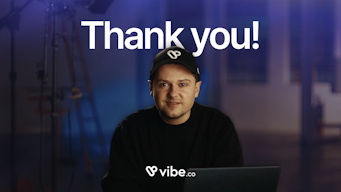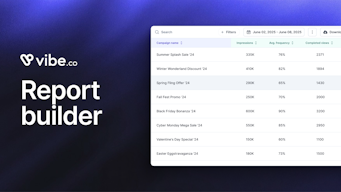A Beginner's Guide to Video Marketing for Small Business
While video marketing consumption is probably already part of your life, you may not have integrated it into your marketing mix, worried it might cost too much or be too complicated. Read on to learn about the evolution of video marketing, the simple tools you can use to get started, the strategies we suggest for success, and the best channels to get started with. But first, let’s define what video marketing even is.
What is video marketing?
In a nutshell, video is a form of content marketing, which is designed to attract and retain a specific audience, helping small businesses make an impact from top of funnel awareness all the way to existing customer nurture. Examples of video marketing campaigns can include a short, muted video for a web retargeting campaign, an unskippable brand awareness commercial on TV, a highly edited social media reel, and everything in between.
When starting out in video marketing, it’s important not to get carried away by all of the bells and whistles of the medium itself, and focus on the business goals you wish to achieve and the audiences you want to reach with it. Some concrete examples of the different ways video marketing can help your small business include:
- Increasing and maintaining your visibility on social feeds
- Getting more exposure and engagement
- Increasing the understanding of your product
- Standing out from the competition
- Providing a more personable way to engage with your audience
- Empowering your salesforce with interactive tools
- Ranking higher in search queries
- Enhancing your other campaigns
Decide which goals and audiences you want to focus on so you can start working on the best type of video format and channels. Once that’s done, we’re off to the races! After all, over 49% of Americans watch a minimum of 5 videos every day. People are hungry for video content, even if the types of video differ.
Different strokes for different folks - video formats
The networking and technology giant Cisco estimates that video traffic will drive 82% of internet traffic this year, but only if it is used in ways that remain relevant to viewers increasingly used to hyper-targeted content. Let’s look at some of the most successful commercial video formats on the market today.
Product demonstration videos
Most of us probably think of either hyper stylized Super Bowl-style TV commercials or skippable YouTube ads when we think of video marketing, but one of the most basic and useful video types are short, well-edited product demonstrations. In the age of User Generated Content (UGC), viewers have gotten used to lower-resolution formats that focus on authenticity, differentiation, and company values. KPIs to follow for this type of video might be promo code usage, organic search volume, or social media shares.
This video from disruptive beauty startup The Lip Bar is a great example of low production, high impact videos.
Behind-the-scenes videos
To interact with existing customers and nurture loyalty, a different type of video, like a behind the scenes one, for example, can be helpful. This type of content helps create trust with customers increasingly hungry for authentic brand messaging. It’s also versatile, as it can be shared across social platforms or in email campaigns. KPIs for this type of video might be lower cart abandonment rates, more returning users, or social media mentions. Take a look at the video from the dating app Bumble as it demystifies the app for potentially shy customers.
Testimonial videos
89% of U.S. adults trust consumer reviews more than any other source of information when researching new products or services, so don’t skimp on testimonials! KPIs for this type of video might be click through rates, view through rates, or an increase in paid search campaign performance. Take a look at this great example from Huntington Bank, who brought their Unique Selling Proposition to life in this great video.
Brand introduction videos
Brand introduction videos are especially important to help differentiate small and medium businesses from their competitors.They should include a compelling description of the solutions your brand offers as well as the inner workings of the business, its history, beliefs, and mission statement.
Although the longer format and need for a compelling storytelling arc might make it more of a challenge to film, this type of video can be repurposed across campaigns, on your website, social media, client proposals, streaming TV ads, and more, so it’s worth the investment. KPIs for this type of video could include: returning users, consideration lift, view through rates, or click through rates.
Look at how well Warby Parker utilized this format to emphasize the sustainability, high quality design, and philanthropic reach of their company.
Where do I put all this stuff?! Picking the right video channels
Just as strategic planning and audience targeting need to be front and center for any impactful video marketing campaign, the types of channels you choose to distribute those videos on will make a huge difference on how efficiently your campaign results can be tracked and optimized. Let’s have a look at the different types of channels available to video marketers, and which types of content best suit each one.
Social media
Social media videos are incredibly varied in format, from short, muted clips in your feed all the way to 20 minute, highly stylized tutorials on YouTube or Instagram reels. The key to creating a solid video campaign for social media is to understand the type of audience you’re going after and customize the videos as much as possible to attract that audience’s attention. Many social media videos are muted by default and almost all of them exist in a scrollable environment, so customization and strong CTAs at the very start of the video are key. Most social media viewers change videos after 45 seconds, no matter how long it is so keep yours short, graphic, and relevant.
DOOH
DOOH stands for Digital Out Of Home marketing - essentially digital billboards, and they’ve come a long way! Thanks to digital services like Blip, marketers can select billboards across the country, upload their creative, and optimize performance in real-time, while creating engaging, relevant experiences for their customers in a fresh way. Try to make these videos as relevant as possible to leverage the magic of out of home targeting, but remember: they need to be muted and translate graphically for viewers watching it from far away.
Website
Website videos are typically aimed at customers further down the funnel, who have already engaged with your brand in some other capacity along their customer journey, so think of these videos as your opportunity to “close the deal.” Take your time to craft a compelling story with some emotional pull and a strong CTA (Call To Action) at the end. After all, what a customer who is already on your website needs is reassurance that they are on the right track, not brand awareness. So focus on creating an emotional connection with your audience and moving them towards your product or services page.
Search ads
As unsexy as it might sound, the key to a successful search campaign with video is to optimize your existing creative as much as possible for search engines to recognize the value and relevance of your content. That means that beyond the video itself, special attention will have to be paid to the title, description, and tagging of each video component. While the type of video you choose to highlight for your search campaign depends on your strategic goals, it’s crucial to optimize the following in order to rank: a custom thumbnail image, video transcript, quick loading time, solid meta descriptions, and consistency between the targeted query and your content.
Streaming TV
CTV (Connected TV) advertising has taken the advertising world by storm, ever since the pandemic-induced rush to streaming services and on-demand TV. While TV advertising may not have been accessible to small and medium businesses when contracts took months to outline and budgets ran in the millions, streaming TV can now offer the premium inventory advertisers need (ESPN, Bravo, Fox, NBC, etc.) at budgets beginning at $500/campaign. Add to that the granular targeting and tracking capabilities of digital and CTV is now the fastest growing digital channel in the market. In order to develop simple, targetable, affordable video campaigns at scale, make sure to work with a programmatic CTV ad platform that can help you deliver and track thousands of ads on premium channels, in minutes.
Email communications are a great way to nurture relationships with your customer base. The types of videos you will need to focus on will vary with the types of lists you send them to, but no matter how deep in the funnel your recipients are, remember that this medium is ideal for long-term relationship building. In this case, it’s not about one splashy video, but a coherent cadence that will remain relevant over time. Make sure the esthetic, tone, and even actors/employees remain consistent over time so your customers can develop a sense of trust and comfort with your communications team.
How to get started - Best Practices
Remember, creating a video does not have to break the bank. In most cases, a smart phone with a tripod and a clean background is all you need, as long as your videos are thoughtfully made to meet your business goals. Here are some of the top practices to keep in mind, across formats and channels.
- Try to keep any dialogue as organic as possible. More than ever, customers are looking for authenticity in marketing.
- Make a practice of regularly browsing social media mentions in order to identify User Generated Content (UGC) that you can use in your own content.
- Keep videos short, to the point, and easy to share.
- Work on easily customizable templates that can work for targeted audiences. According to McKinsey & Company, 71% of consumers expect companies to deliver personalized interactions and 76% get frustrated when this doesn't happen.
- At the end of the day, people like to watch people. Our brains have mirror neurons that fire when we observe the facial expressions of others, causing us to empathize with them. Don’t underestimate the power of empathy in your creative!
- Test early and test often. Video marketing is a digital channel par excellence. Take advantage of that flexibility!
Whether you’re looking for brand awareness, increased traffic, or campaign performance, video marketing can meet your small and medium business needs across channels, as long as the format and messaging match your strategy.



